Page 120 of 587
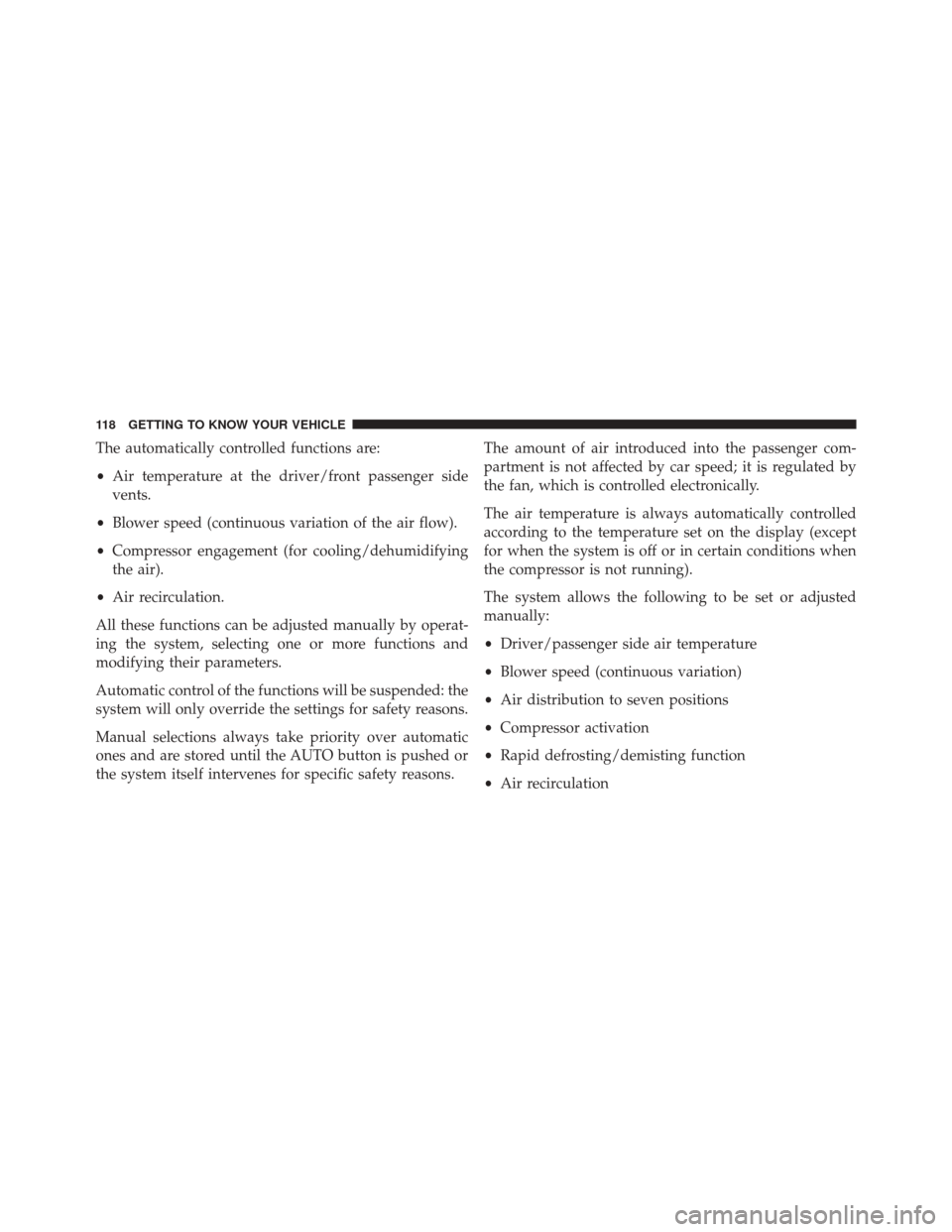
The automatically controlled functions are:
•Air temperature at the driver/front passenger side
vents.
• Blower speed (continuous variation of the air flow).
• Compressor engagement (for cooling/dehumidifying
the air).
• Air recirculation.
All these functions can be adjusted manually by operat-
ing the system, selecting one or more functions and
modifying their parameters.
Automatic control of the functions will be suspended: the
system will only override the settings for safety reasons.
Manual selections always take priority over automatic
ones and are stored until the AUTO button is pushed or
the system itself intervenes for specific safety reasons. The amount of air introduced into the passenger com-
partment is not affected by car speed; it is regulated by
the fan, which is controlled electronically.
The air temperature is always automatically controlled
according to the temperature set on the display (except
for when the system is off or in certain conditions when
the compressor is not running).
The system allows the following to be set or adjusted
manually:
•
Driver/passenger side air temperature
• Blower speed (continuous variation)
• Air distribution to seven positions
• Compressor activation
• Rapid defrosting/demisting function
• Air recirculation
118 GETTING TO KNOW YOUR VEHICLE
Page 122 of 587
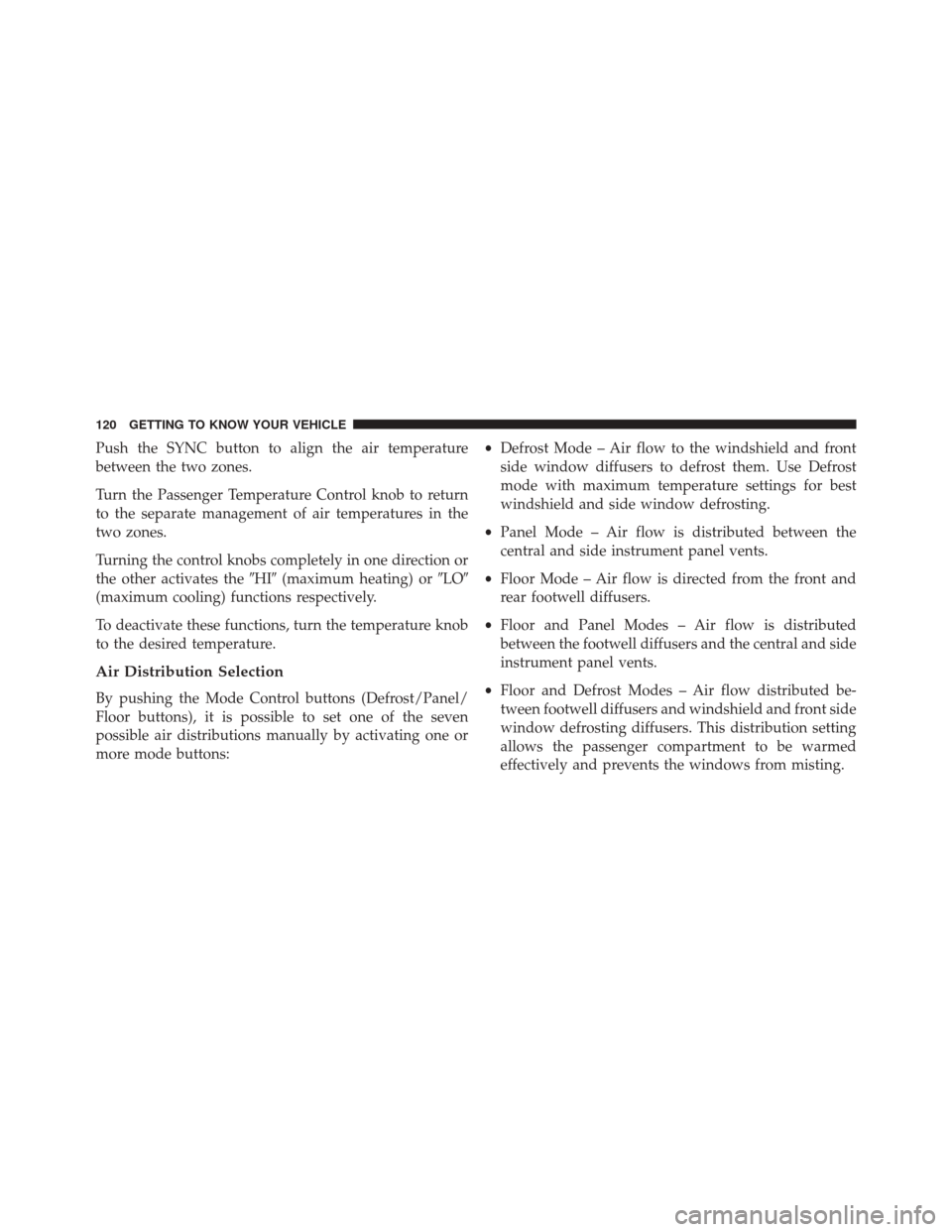
Push the SYNC button to align the air temperature
between the two zones.
Turn the Passenger Temperature Control knob to return
to the separate management of air temperatures in the
two zones.
Turning the control knobs completely in one direction or
the other activates the�HI�(maximum heating) or �LO�
(maximum cooling) functions respectively.
To deactivate these functions, turn the temperature knob
to the desired temperature.
Air Distribution Selection
By pushing the Mode Control buttons (Defrost/Panel/
Floor buttons), it is possible to set one of the seven
possible air distributions manually by activating one or
more mode buttons: •
Defrost Mode – Air flow to the windshield and front
side window diffusers to defrost them. Use Defrost
mode with maximum temperature settings for best
windshield and side window defrosting.
• Panel Mode – Air flow is distributed between the
central and side instrument panel vents.
• Floor Mode – Air flow is directed from the front and
rear footwell diffusers.
• Floor and Panel Modes – Air flow is distributed
between the footwell diffusers and the central and side
instrument panel vents.
• Floor and Defrost Modes – Air flow distributed be-
tween footwell diffusers and windshield and front side
window defrosting diffusers. This distribution setting
allows the passenger compartment to be warmed
effectively and prevents the windows from misting.
120 GETTING TO KNOW YOUR VEHICLE
Page 123 of 587
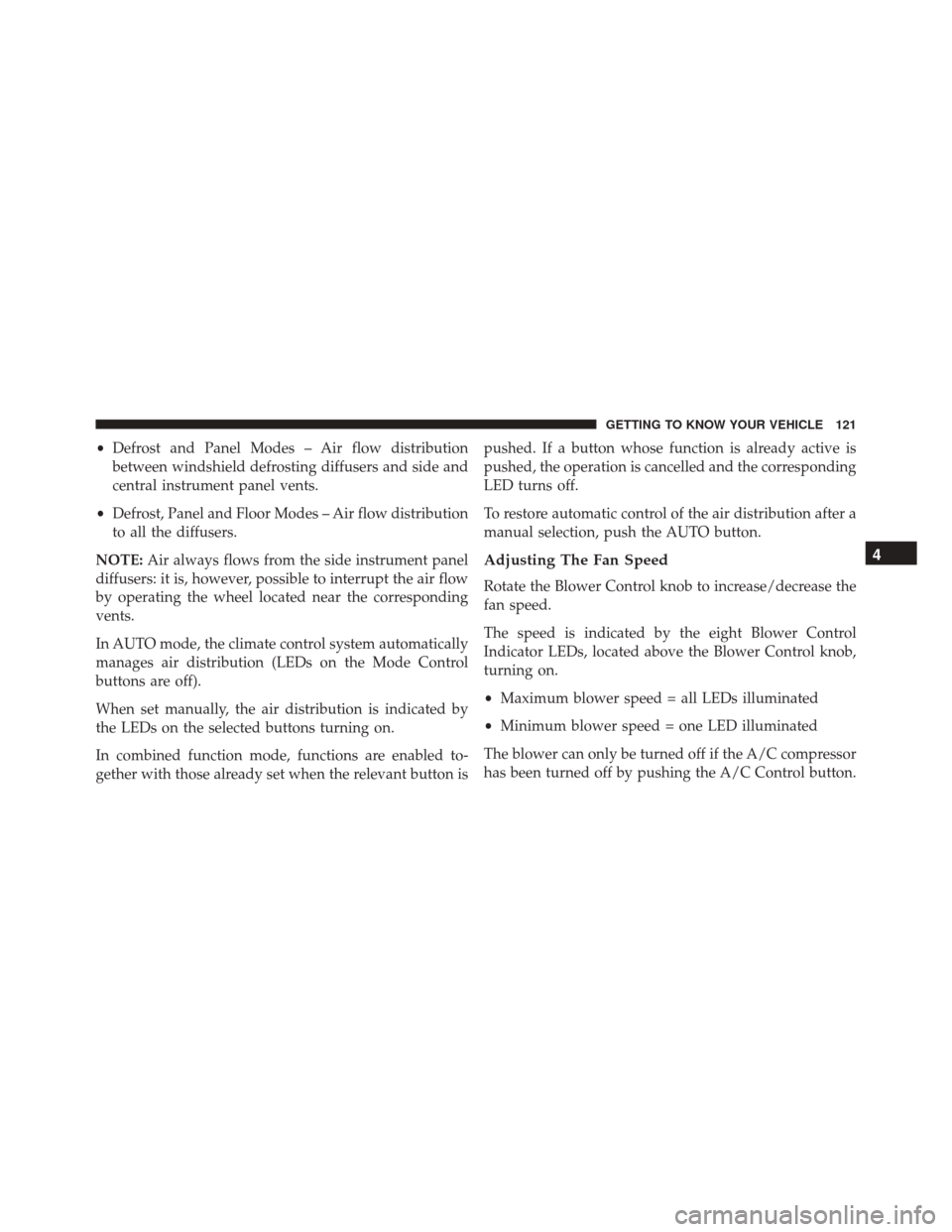
•Defrost and Panel Modes – Air flow distribution
between windshield defrosting diffusers and side and
central instrument panel vents.
• Defrost, Panel and Floor Modes – Air flow distribution
to all the diffusers.
NOTE: Air always flows from the side instrument panel
diffusers: it is, however, possible to interrupt the air flow
by operating the wheel located near the corresponding
vents.
In AUTO mode, the climate control system automatically
manages air distribution (LEDs on the Mode Control
buttons are off).
When set manually, the air distribution is indicated by
the LEDs on the selected buttons turning on.
In combined function mode, functions are enabled to-
gether with those already set when the relevant button is pushed. If a button whose function is already active is
pushed, the operation is cancelled and the corresponding
LED turns off.
To restore automatic control of the air distribution after a
manual selection, push the AUTO button.
Adjusting The Fan Speed
Rotate the Blower Control knob to increase/decrease the
fan speed.
The speed is indicated by the eight Blower Control
Indicator LEDs, located above the Blower Control knob,
turning on.
•
Maximum blower speed = all LEDs illuminated
• Minimum blower speed = one LED illuminated
The blower can only be turned off if the A/C compressor
has been turned off by pushing the A/C Control button.
4
GETTING TO KNOW YOUR VEHICLE 121
Page 125 of 587
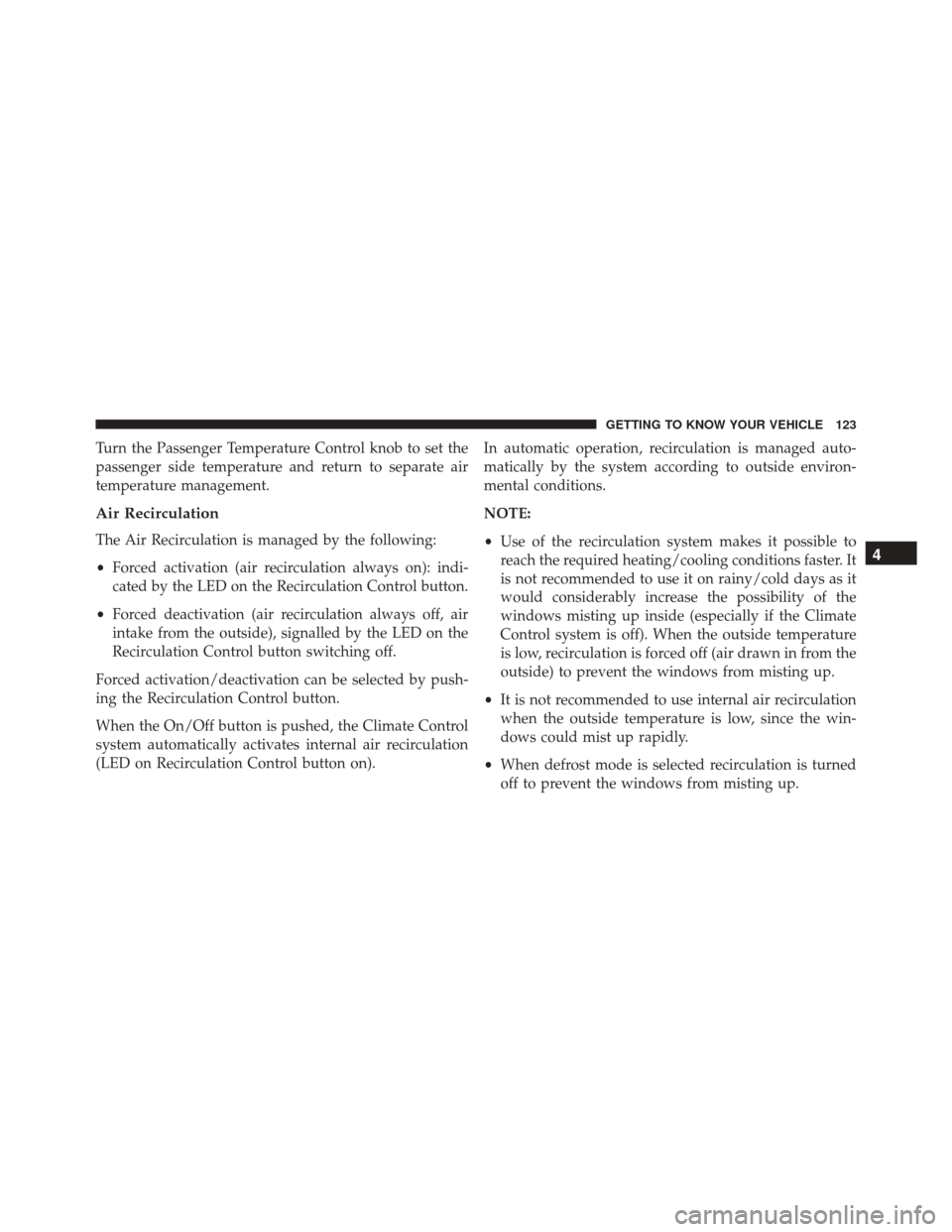
Turn the Passenger Temperature Control knob to set the
passenger side temperature and return to separate air
temperature management.
Air Recirculation
The Air Recirculation is managed by the following:
•Forced activation (air recirculation always on): indi-
cated by the LED on the Recirculation Control button.
• Forced deactivation (air recirculation always off, air
intake from the outside), signalled by the LED on the
Recirculation Control button switching off.
Forced activation/deactivation can be selected by push-
ing the Recirculation Control button.
When the On/Off button is pushed, the Climate Control
system automatically activates internal air recirculation
(LED on Recirculation Control button on). In automatic operation, recirculation is managed auto-
matically by the system according to outside environ-
mental conditions.
NOTE:
•
Use of the recirculation system makes it possible to
reach the required heating/cooling conditions faster. It
is not recommended to use it on rainy/cold days as it
would considerably increase the possibility of the
windows misting up inside (especially if the Climate
Control system is off). When the outside temperature
is low, recirculation is forced off (air drawn in from the
outside) to prevent the windows from misting up.
• It is not recommended to use internal air recirculation
when the outside temperature is low, since the win-
dows could mist up rapidly.
• When defrost mode is selected recirculation is turned
off to prevent the windows from misting up.4
GETTING TO KNOW YOUR VEHICLE 123
Page 126 of 587
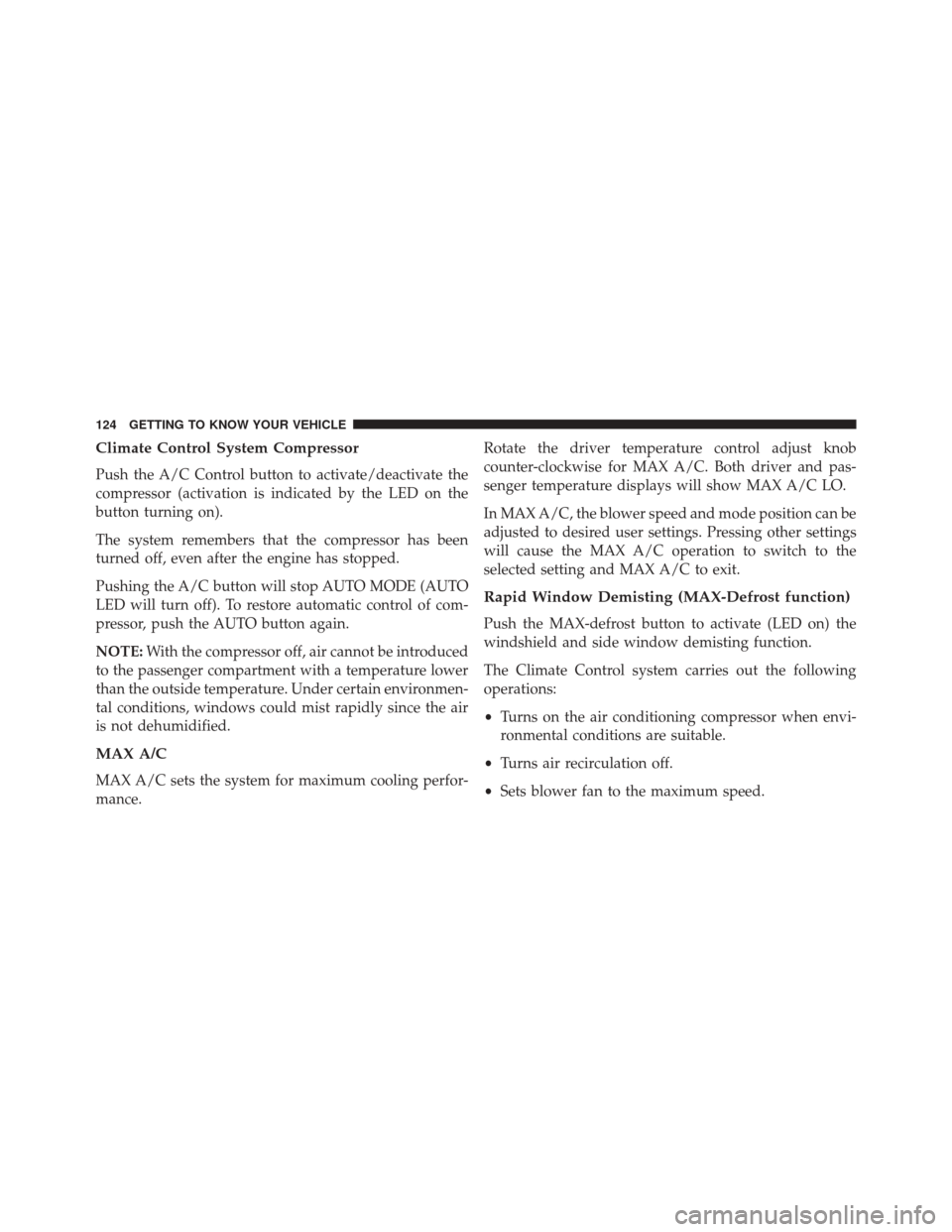
Climate Control System Compressor
Push the A/C Control button to activate/deactivate the
compressor (activation is indicated by the LED on the
button turning on).
The system remembers that the compressor has been
turned off, even after the engine has stopped.
Pushing the A/C button will stop AUTO MODE (AUTO
LED will turn off). To restore automatic control of com-
pressor, push the AUTO button again.
NOTE:With the compressor off, air cannot be introduced
to the passenger compartment with a temperature lower
than the outside temperature. Under certain environmen-
tal conditions, windows could mist rapidly since the air
is not dehumidified.
MAX A/C
MAX A/C sets the system for maximum cooling perfor-
mance. Rotate the driver temperature control adjust knob
counter-clockwise for MAX A/C. Both driver and pas-
senger temperature displays will show MAX A/C LO.
In MAX A/C, the blower speed and mode position can be
adjusted to desired user settings. Pressing other settings
will cause the MAX A/C operation to switch to the
selected setting and MAX A/C to exit.
Rapid Window Demisting (MAX-Defrost function)
Push the MAX-defrost button to activate (LED on) the
windshield and side window demisting function.
The Climate Control system carries out the following
operations:
•
Turns on the air conditioning compressor when envi-
ronmental conditions are suitable.
• Turns air recirculation off.
• Sets blower fan to the maximum speed.
124 GETTING TO KNOW YOUR VEHICLE
Page 127 of 587
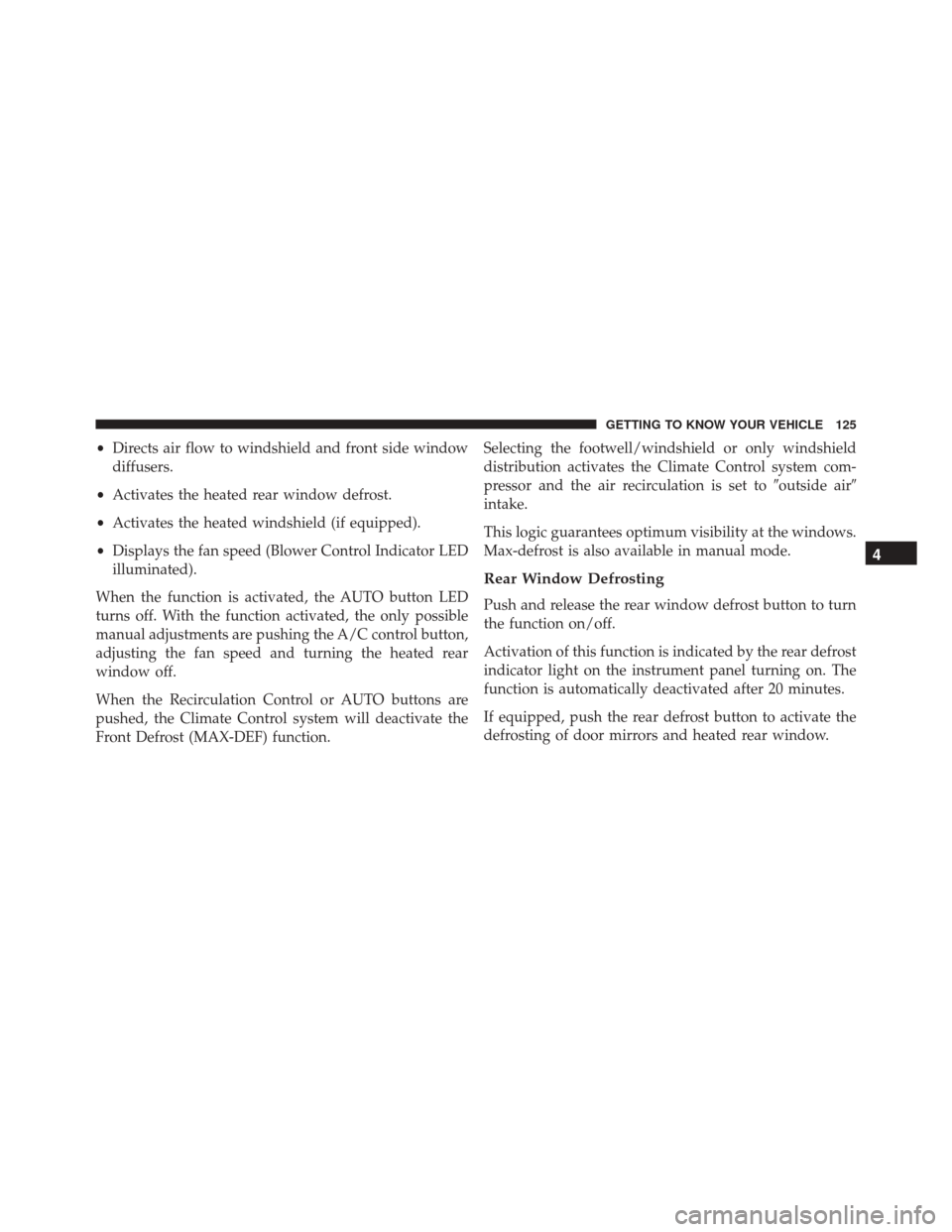
•Directs air flow to windshield and front side window
diffusers.
• Activates the heated rear window defrost.
• Activates the heated windshield (if equipped).
• Displays the fan speed (Blower Control Indicator LED
illuminated).
When the function is activated, the AUTO button LED
turns off. With the function activated, the only possible
manual adjustments are pushing the A/C control button,
adjusting the fan speed and turning the heated rear
window off.
When the Recirculation Control or AUTO buttons are
pushed, the Climate Control system will deactivate the
Front Defrost (MAX-DEF) function. Selecting the footwell/windshield or only windshield
distribution activates the Climate Control system com-
pressor and the air recirculation is set to
�outside air�
intake.
This logic guarantees optimum visibility at the windows.
Max-defrost is also available in manual mode.
Rear Window Defrosting
Push and release the rear window defrost button to turn
the function on/off.
Activation of this function is indicated by the rear defrost
indicator light on the instrument panel turning on. The
function is automatically deactivated after 20 minutes.
If equipped, push the rear defrost button to activate the
defrosting of door mirrors and heated rear window.
4
GETTING TO KNOW YOUR VEHICLE 125
Page 137 of 587
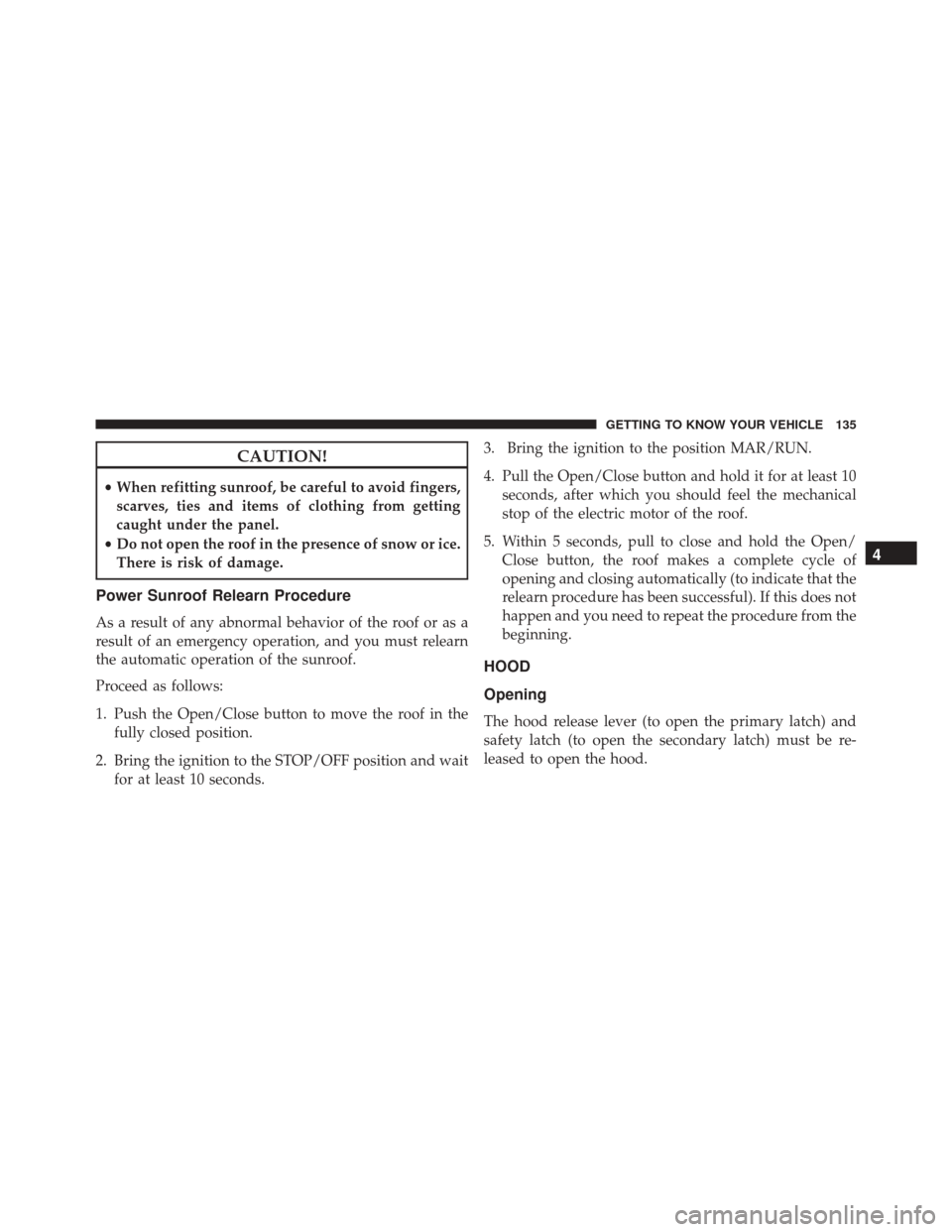
CAUTION!
•When refitting sunroof, be careful to avoid fingers,
scarves, ties and items of clothing from getting
caught under the panel.
• Do not open the roof in the presence of snow or ice.
There is risk of damage.
Power Sunroof Relearn Procedure
As a result of any abnormal behavior of the roof or as a
result of an emergency operation, and you must relearn
the automatic operation of the sunroof.
Proceed as follows:
1. Push the Open/Close button to move the roof in the fully closed position.
2. Bring the ignition to the STOP/OFF position and wait for at least 10 seconds. 3. Bring the ignition to the position MAR/RUN.
4. Pull the Open/Close button and hold it for at least 10
seconds, after which you should feel the mechanical
stop of the electric motor of the roof.
5. Within 5 seconds, pull to close and hold the Open/ Close button, the roof makes a complete cycle of
opening and closing automatically (to indicate that the
relearn procedure has been successful). If this does not
happen and you need to repeat the procedure from the
beginning.
HOOD
Opening
The hood release lever (to open the primary latch) and
safety latch (to open the secondary latch) must be re-
leased to open the hood.
4
GETTING TO KNOW YOUR VEHICLE 135
Page 139 of 587
NOTE:
•Before lifting the hood, check that the wiper arms are
not in motion and not in the lifted position.
• While lifting the hood, use both hands.
• Vehicle must be at a stop and the automatic transmis-
sion must be in park. Manual transmission vehicles
must have the electric park brake engaged.
Closing
1. Hold up the hood with one hand and with the other hand remove the support rod from its seat and reinsert
it into the locking tab.
2. Lower the hood to approximately 6 inches (15 cm) from the engine compartment and drop it. Make sure
that the hood is completely closed.
Hood Prop System
1 — Locking Tab
2 — Support Rod
2 — Support Rod Seat
4
GETTING TO KNOW YOUR VEHICLE 137